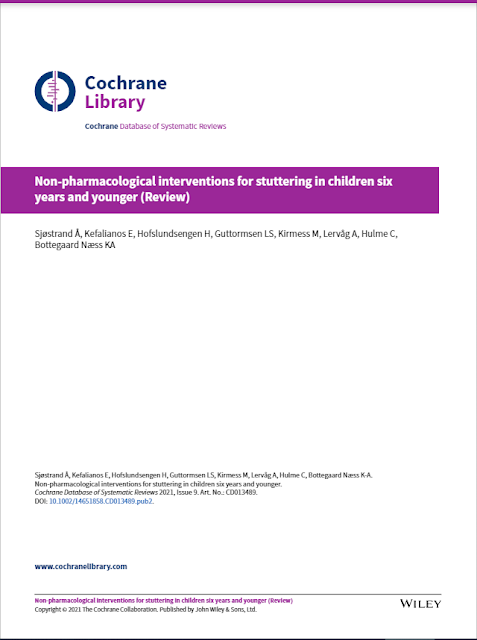The European
day for speech-language pathologist on March 6th focused on telepractice and digital
technologies. Not only intervention and treatment are going online this days, conference
are, too. In this blog post, we reflect about the Oxford dysfluency conference,
which was held digitally in January this year.
The members
of the EST group were presented with a variety of posters and talks, both of
EST-project data, but also on other topics within stuttering such as Stuttering
in an Age Cohort of Children with Down Syndrome by Kari-Anne Bottegaard Næss
and colleagues.
Here we
have sampled a few “snaps” and thoughts about the conference.
Ineke
Samson presented a poster with the title Severity of overt stuttering in
females and males, self-assessed and assessed by SLPs, in relation to
associated symptoms. The poster accounts for a study where the aim is to investigate
impact of stuttering on life quality in female and male teenagers and young
adults who stutter, when controlled for overt stuttering severity. In an
earlier study by Ineke and colleagues (Samson, Lindström, Sand, Herlitz, &
Schalling, 2020) it was concluded that female teenagers who stutter report a
larger impact of stuttering and more negative reactions to communication than
their male peers. The present study aimed at extending the findings in that
report, by adding measures that enable comparisons between overt stuttering
severity (both self-rated and rated by SLPs) and the impact of stuttering on
life quality. https://app.oxfordabstracts.com/submissions/191713/question/28472/download
Many
interesting results and perspectives were reported and discussed during the
conference. What Ineke found especially worth considering was researchers who
suggested and argued that we should appreciate, rather than single out and
separate, differences that exist in people. Why not describe stuttering as part
of "neurological diversity" instead of a "neurological deficit”
since diversity is part of the human experience? Many interesting presentations
and discussions highlighted how stuttering in the (medical-) society is
perceived as a problem that must be "fixed" by the person her- or himself.
Instead, we may consider whether it is not society that needs to be reformed and
"fixed", that everyone is included and can participate on equal
terms.
Åse
Sjøstrand presented a poster together with Linn Guttormsen and Marthe Vasvik
Varpe about Caregivers
ratings of concern for stuttering in young children.

Linn related their poster to a presentation by Scott Yaruss about assessing
stuttering severity with self-report. She commented, that attending this talk
before our poster was a good preparation and stimulated thoughts
concerning what stuttering severity is if we only include the perspective
of the listener and not the person who stutters. In our study, we assessed
mothers', fathers' and kindergarten teachers' perceptions of stuttering
severity and also their level concern. What we learned from this study was that
we have to take into account the perspective of the person who is providing the
information when conducting assessment. We were lucky to have engaged SLPs and
researchers coming to our poster presentation, asking us questions and giving
us new ideas. For instance, the study conducted by Millard, Zebrowski, and Kelman
(2018) also revealed interesting mechanisms in relation to parental concern for
stuttering.
Concerning specific EST-data, Melanie Kirmess presented
a poster entitled Do early childhood professionals in Norway distinguish
between stuttering and normal childhood dysfluencies?,
co-authored by Hilde Hofslundsengen, Linn S. Guttormsen, Elisabeth
Holm Hansen and Kari-Anne Bottegaard Næss. This poster was based on
some of the data from our multi-disciplinary survey for early childhood professionals.
In Norway, we have historically used the term ”stotring” in addition to the
more defined term stuttering. Hence, we wanted to know how professionals understand
those two terms and not the least, if they use them to differentiate between
stuttering and normal dysfluencies. We
were also curious if this topic concerning a small Norwegian feature would
attract any other listeners at all, and yes – it did, and we had some nice discussions
and feedback.

Missing out on meeting colleagues in Oxford, the EST group concluded the
Oxford conference with a digital evening ”wine and talk” seminar for ourselves,
having the time to discuss other presentations and impressions. The best thing
with a digital conference like this is definitely the opportunity to watch
presentations for some additional time after the formal conclusion of the
conference.

















